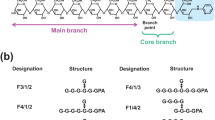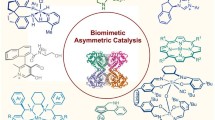Abstract
We successfully engineered a new enzyme that catalyzes the formation of d-Ala amide (d-AlaNH2) from d-Ala by modifying ATP-dependent d-Ala:d-Ala ligase (EC 6.3.2.4) from Thermus thermophilus, which catalyzes the formation of d-Ala-d-Ala from two molecules of d-Ala. The new enzyme was created by the replacement of the Ser293 residue with acidic amino acids, as it was speculated to bind to the second d-Ala of d-Ala-d-Ala. In addition, a replacement of the position with Glu performed better than that with Asp with regards to specificity for d-AlaNH2 production. The S293E variant, which was selected as the best enzyme for d-AlaNH2 production, exhibited an optimal activity at pH 9.0 and 40 °C for d-AlaNH2 production. The apparent Km values of this variant for d-Ala and NH3 were 7.35 mM and 1.58 M, respectively. The S293E variant could catalyze the synthesis of 9.3 and 35.7 mM of d-AlaNH2 from 10 and 50 mM d-Ala and 3 M NH4Cl with conversion yields of 93 and 71.4 %, respectively. This is the first report showing the enzymatic formation of amino acid amides from amino acids.




Similar content being viewed by others
References
Asano Y (2010) Tools for enzyme discovery-industrial enzymes, biocatalysis and enzyme evolution. Man Ind Microbiol Biotechnol, 441–452
Asano Y, Yamaguchi S (2005) Dynamic kinetic resolution of amino acid amide catalyzed by D-aminopeptidase and α-amino-ε-caprolactam racemase. J Am Chem Soc 127:7696–7697
Brennan TM, Hendrick ME (1983) Branched amides of l-aspartyl-d-amino acid dipeptides. US Patent 4:411–925
Breuer M, Ditrich K, Habicher T, Hauer B, Kesseler M, Stürmer R, Zelinski T (2004) Industrial methods for the production of optically active intermediates. Angew Chem Int Ed Engl 43:788–824
Dutta AS (2009) Discovery of New Medicine. The Textbook of Pharmaceutical Medicine. (Griffin, JP. ed. 6th Edition). Wiley, Chichester, pp 3–80
Ghislieri D, Houghton D, Green AP, Willies SC, Turner NJ (2013) Monoamine oxidase (MAO-N) catalyzed deracemization of tetrahydro-β-carbolines: substrate dependent switch in enantioselectivity. ACS Catal 3:2869–2872
Goto J, Kataoka R (2008) ASEDock-docking based on alpha spheres and excluded volumes. J Chem Inf Model 48:583–590
Fan C, Moews PC, Walsh CT, Knox JR (1994) Vancomycin resistance: structure of d-alanine:d-alanine ligase at 2.3 Å resolution. Science 266:439–443
Fan C, Park IS, Walsh CT, Knox JR (1997) d-Alanine:d-alanine ligase: phosphonate and phosphinate intermediates with wild type and the Y216F mutant. Biochemistry 36:2531–2538
Goswami A, Van Lanen SG (2015) Enzymatic strategies and biocatalysts for amide bond formation: tricks of the trade outside of the ribosome. Mol BioSyst 11:338–353
Gröger H, Asano Y (2012) Introduction-principles and historical landmarks of enzyme catalysis in organic synthesis. Enzyme Catalysis in Organic Synthesis, Third Edition, pp 1–42
Gröger H, Asano Y, Bornscheuer UT, Ogawa J (2012) Development of biocatalytic processes in Japan and Germany: from research synergies to industrial applications. Chem Asian J 7:1138–1153
Kato Y, Asano Y, Nakazawa A, Kondo K (1989) First stereoselective synthesis of d-amino acid N-alkyl amide catalyzed by d-aminopeptidase. Tetrahedron 45:5743–5754
Kawahara N, Asano Y (2015) Mutagenesis of an Asn156 residue in a surface region of S-selective hydroxynitrile lyase from Baliospermum montanum enhances catalytic efficiency and enantioselectivity. ChemBioChem 16:1891–1895
Kitamura Y, Ebihara A, Agari Y, Shinkai A, Hirotsu K, Kuramitsu S (2009) Structure of d-alanine-D-alanine ligase from Thermus thermophilus HB8: cumulative conformational change and enzyme–ligand interactions. Acta Crystallogr D Biol Crystallogr 65:1098–1106
Komeda H, Asano Y (1999) Synthesis of d-phenylalanine oligopeptides catalyzed by alkaline D-peptidase from Bacillus cereus DF4-B. J Mol Catal B Enzym 6:379–386
McNicholas S, Potterton E, Wilson KS, Noble MEM (2011) Presenting your structures: the CCP4 mg molecular-graphics software. Acta Cryst. D67:386–394
Mullins L, Zawadzke L, Walsh CT, Raushel F (1990) Kinetic evidence for the formation of d-alanyl phosphate in the mechanism of d-alanyl-d-alanine ligase. J Biol Chem 265:8993–8998
Neuhaus FC (1962) The enzymatic synyhesis of D-alanyl-d-alanine: I. Purification and properties of D-alanyl-d-alanine synthetase. J Biol Chem 237:778–786
Sharma J, Batovska D, Kuwamori Y, Asano Y (2005) Enzymatic chemoselective synthesis of secondary-amide surfactant from N-methylethanol amine. J Biosci Bioeng 100:662–666
Tsuda T, Asami M, Koguchi Y, Kojima S (2014) Single mutation alters the substrate specificity of l-amino acid ligase. Biochemistry 53:2650–2660
van Rantwijk F, Hacking MA, Sheldon RA (2000) Lipase-catalyzed synthesis of carboxylic amides: nitrogen nucleophiles as acyl acceptor. Monatsh Chem 131:549–569
Wehofsky N, Pech A, Liebscher S, Schmidt S, Komeda H, Asano Y, Bordusa F (2008) d-Amino acid specific proteases and native all-l-proteins: a convenient combination for semisynthesis. Angew Chem Int Ed Engl 47:5456–5460
Winn MD, Ballard CC, Cowtan KD, Dodson EJ, Emsley P, Evans PR, Keegan RM, Krissinel EB, Leslie AGW, McCoy A, McNicholas SJ, Murshudov GN, Pannu NS, Potterton EA, Powell HR, Read RJ, Vagin A, Wilson S (2011) Overview of the CCP4 suite and current developmentts. Acta Cryst. D67:235–242
Yamaguchi S, Komeda H, Asano Y (2007) New enzymatic method of chiral amino acid synthesis by dynamic kinetic resolution of amino acid amides: use of stereoselective amino acid amidases in the presence of α-amino-ε-caprolactam racemase. Appl Environ Microbiol 73:5370–5373
Yasukawa K, Asano Y (2012) Enzymatic synthesis of chiral phenylalanine derivatives by a dynamic kinetic resolution of corresponding amide and nitrile substrates with a multi-enzyme system. Adv Synth Catal 354:3327–3332
Yasukawa K, Nakano S, Asano Y (2014) Tailoring d-amino acid oxidase from the pig kidney to R-stereoselective amine oxidase and its use in the deracemization of α-methylbenzylamine. Angew Chem Int Ed Engl 53:4428–4431
Acknowledgments
We thank Dr. Kimiyasu Isobe for his fruitful discussion, critical preparation and reading of the manuscript. S.O. acknowledges Prof. Hiroaki Tokiwa of Rikkyo University for computational and analytic support. This work was supported by the Exploratory Research for Advanced Technology (ERATO) Asano Active Enzyme Molecule Project of Japan Science and Technology Agency (JST).
Author information
Authors and Affiliations
Corresponding author
Electronic supplementary material
Below is the link to the electronic supplementary material.
10295_2016_1833_MOESM1_ESM.docx
Fig. S1 The structures of the overall folding (A) and the substrate recognition sites (B) of TtDdL. The original PDB file is 2ZDQ [15]. The graphic was visualized with the Pymol program (DOCX 395 kb)
10295_2016_1833_MOESM2_ESM.docx
Fig. S2 SDS-PAGE of the E. coli soluble fractions containing recombinant TtDdL from S293X. Wt is wild type enzyme, and alphabets are amino acid codes of X in S293X variants (DOCX 343 kb)
10295_2016_1833_MOESM3_ESM.docx
Fig. S3. A typical LC-MS chromatogram and the MS/MS patterns of the reaction products from d-Ala. The S293D variant was incubated with 10 mM d-Ala, 0.1 M NH4Cl, 10 mM ATP, 5 mM MgCl2, and 0.1 M KCl at pH 9.0 and 40°C for 12hours. The reaction products were analyzed by LC-MS and MS/MS as described in Materials and methods. The peak corresponding to d-Ala-d-Ala was eluted at 15.8 minutes. The new peak detected at 11.4 minutes was identified as d-AlaNH2 by the retention time and the MS/MS pattern of the authentic compound. The peak at 12.4 minutes was identified as d-Ala-d-AlaNH2 by comparison of the MS/MS pattern (DOCX 127 kb)
10295_2016_1833_MOESM4_ESM.docx
Fig. S4. Effects of ATP concentration on the production of d-AlaNH2 by the S293E variant. The d-AlaNH2 production was performed by incubation at 40°C for 12 hours at pH 9.0 using 25 mM or 50 mM d-Ala and 3 M NH4Cl as substrate. ATP added into the reaction mixture was changed as follows: 25 mM or 50 mM ATP was added to 25 mM d-Ala, and 50 mM or 100 mM ATP was added to 50 mM d-Ala. The concentrations of d-AlaNH2, d-Ala-d-Ala and remaining d-Ala are shown as the black, gray and white bars, respectively. Means and 95% confidence limits are shown (DOCX 43 kb)
10295_2016_1833_MOESM5_ESM.docx
Fig. S5. Comparison of the d-Ala2 binding sites among crystal structure of EcDdL (coral; PDB ID 1IOW) and homology modeled TtDdL structures of wild type (gray), S293D variant (gold) and S293E variant (ice blue). The figure was prepared by superposition of EcDdL, homology modelled TtDdL (wild type, S293D and S293E variants) on TtDdL (PDB ID 2ZDQ). Broken red lines represent hydrogen bonds. The figure was produced using CCP4mg [17] (DOCX 490 kb)
10295_2016_1833_MOESM6_ESM.docx
Fig. S6. Comparison of the modelled S293 variants in closed form. S293D variant (gold) and S293E variant (ice blue). Broken red lines represent hydrogen bonds. The figure was produced using CCP4mg [17] (DOCX 254 kb)
10295_2016_1833_MOESM7_ESM.docx
Fig. S7. Comparison of the modelled S293 variants in closed form. S293I variant (cyan), S293M variant (pink) and S293V variant (purple). Broken lines represent distances. The figure was produced using CCP4mg [17] (DOCX 335 kb)
Rights and permissions
About this article
Cite this article
Miki, Y., Okazaki, S. & Asano, Y. Engineering an ATP-dependent d-Ala:d-Ala ligase for synthesizing amino acid amides from amino acids. J Ind Microbiol Biotechnol 44, 667–675 (2017). https://doi.org/10.1007/s10295-016-1833-8
Received:
Accepted:
Published:
Issue Date:
DOI: https://doi.org/10.1007/s10295-016-1833-8




